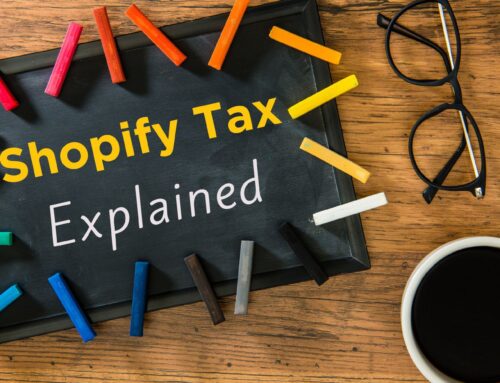
At VM Wasek, we specialize in Shopify accounting and work with a lot of Shopify sellers. What’s the biggest challenge I see time and again while working with these clients? They are dealing with either tracking inventory and cost of goods sold on spreadsheets, using apps, or using Shopify inventory. As their business grows, they begin to struggle with trying to put all of these pieces together to get good numbers for cost of goods sold -then realize they aren’t even sure how it should be calculated. Could this be your struggle too? I’m here to help! Keep reading or click on the video linked below for a look at Shopify cost of goods sold: explained by an accountant.
Inventory terminology
To answer the question of what makes up cost of goods sold, we need to first start with some terminology.
- Inventory includes goods and products that are ready to sell, along with the raw materials and component parts used to produce those goods and products. Sometimes it’s also called inventory on hand.
- COGS or cost of goods sold are the expenses directly related to the production of goods and products that have been sold. Cost of goods sold is recorded once the inventory has been sold.
- Landed cost is the total cost of goods and products, once those goods and products have arrived at the seller’s doorstep. This total cost includes transportation, customs duties, taxes, tariffs, insurance, handling, and more. Typically, when we are costing or expensing cost of good sold, we generally want to use landed costs.
The relationship between inventory and cost of goods sold
There is a direct correlation between inventory and cost of goods sold. Think of them as cousins. If inventory goes down, cost of goods sold typically goes up, because that means that we sold inventory. When we sell inventory, we have to recognize the cost of goods sold. The image below shows the relationship as inventory decreases, cost of goods sold increases.

Textbook accounting versus reality
In Shopify accounting, we have a disconnect. As an accountant, what I see is that we have textbook accounting for how we need to track inventory and cost of goods sold versus the reality. The textbook accounting tells us that we need to use an inventory formula, (I’ll talk about in a moment) and valuation ( which is how we will value that inventory). It’s all about perfect numbers and everything needs to reconcile.
And then on the other hand, we have what sellers are really doing, the apps that are available to give us the information that we need in order to capture the right numbers from an accounting perspective. Really, we have limitations in technology right now in the e-commerce space that make it more challenging for smaller sellers and growing sellers to capture the information that we need from an accounting perspective.

Inventory “textbook” accounting
Inventory accounting formula
Let’s start off talking about the inventory textbook accounting. There’s a lot that goes into valuing inventory and cost of goods sold.
First of all, we have the inventory accounting formula. Basically what that means is that there’s a methodical way in which inventory and cost of goods sold should be calculated, and in particular, cost of goods sold. The formula for calculating cost of goods sold is:
Beginning inventory (+) Purchases (-) Ending inventory = Cost of goods sold.
Take a look at the formula shown chart below.

Inventory valuation
Inventory valuation refers to how we’re going to value the inventory. The general methods available for inventory valuation are landed cost, FIFO (means first in, first out), LIFO (last in, first out), weighted average, and lower of cost or market.
Inventory System
Last on the chart above, you have the inventory system that you will use to track your inventory. The two types are periodic inventory method, meaning you’ll adjust inventory on a monthly basis or quarterly basis or annual basis, or a perpetual method in which inventory is being updated in real time.
Components of inventory
For accounting purposes, we also have to consider that there are components of inventory. These components include:
- Vendor and supplier deposits. These are monies that have been advanced to vendors for inventory that hasn’t been received yet.
- Inventory in transit. That is the inventory that is on its way to you as the seller. You can’t sell that inventory yet because you haven’t received it.
- Inventory on hand. That is the inventory that you have in your possession or in a warehouse that can be sold. That inventory may have already been paid for, but part of that inventory, depending on your vendor terms, may be unpaid for. Those are all things that we have to consider when we’re doing the accounting.
- Inventory that has been sold. That is the goods and products that have been sold and removed from your inventory.
Click the following link to watch me walk through a very simple example of inventory accounting in my related video. [Link to video at 5:16]
Shopify inventory workflow challenges
Remember when I said there is a direct correlation between inventory and cost of goods sold? That means that in that ‘perfect accounting world’, everything reconciles. But we have some challenges:
- When we’re dealing with Shopify inventory, or e-commerce inventory in general, we’re dealing with a high volume of transactions. You can’t really track cost of goods sold for each transaction – certainly not in QuickBooks, or generally not in accounting software.
- When you’re dealing with your inventory costing. You have varying costs and landed costs where prices are increasing, and your inventory cost is changing over time.
- There is disjointed data. We have data from Shopify, from your fulfillment center, from purchases from sales, and everything lives in different places. Your inventory data is not integrated with your sales data and many sellers are just using manual tracking methods, which makes it even more challenging because again we have data that is disjointed.
Shopify cost of goods sold
If you’re a Shopify seller, you might have noticed when you look at your finances summary that there’s an amount for cost of goods sold. Can you use that amount for bookkeeping? Well, because of the following limitations, I would have you steer away from using that number.
- All products and Shopify must be updated for landed costs. If you’re not keeping track of your costs in Shopify, you’re not updating those balances, then you’re not going to get good numbers.
- There’s also no correlation between what’s being tracked by Shopify and what’s actually being recorded on the books.
- The Shopify cost of goods sold calculation is not based on the inventory accounting formula that we talked about earlier.
Remember, the inventory accounting formula I shared earlier is:
Beginning inventory (+) Purchases (-) Ending inventory = Cost of goods sold.
Basically, the amount that we see on the Shopify finance summary for cost of goods sold has no correlation to the inventory accounting formula. The way that Shopify is calculating cost of goods sold is just the quantity of inventory sold times a cost. You can’t just update the cost of goods sold amount because it has a direct relationship to the inventory balances and therefore both cost of goods sold and inventory balances have to be correct. So in order to truly track cost of goods sold, we have to at the same time be tracking inventory using this inventory accounting formula.
Click the following link to see a simple example in my related video. [Link to video at 8:48]
So, what’s our big take away? The books are only as accurate as the inventory and cost of goods sold balances that are used. If you have bad inventory numbers, and bad cost of goods sold numbers, and if those numbers don’t reconcile using the inventory accounting formula, then you’ll ultimately have inaccurate financials.
Closing
Now that you’ve heard the ins and outs of Shopify cost of goods sold: explained by an accountant, I hope you have some new clarity. If you are struggling with calculating cost of goods sold for your Shopify business, let me know in the comments. I’d love to hear from you.
If you’re looking for a trusted and reliable Shopify accounting pro to help, you can use this link to learn more about my services and see how we might be able to work together. I’d also love to share a few free resources with you, like my YouTube channel and my free Shopify Bookkeeping Blueprint. If you’d also like to connect with other Shopify sellers and professional bookkeepers, come join my Facebook community. I hope to see you there!




